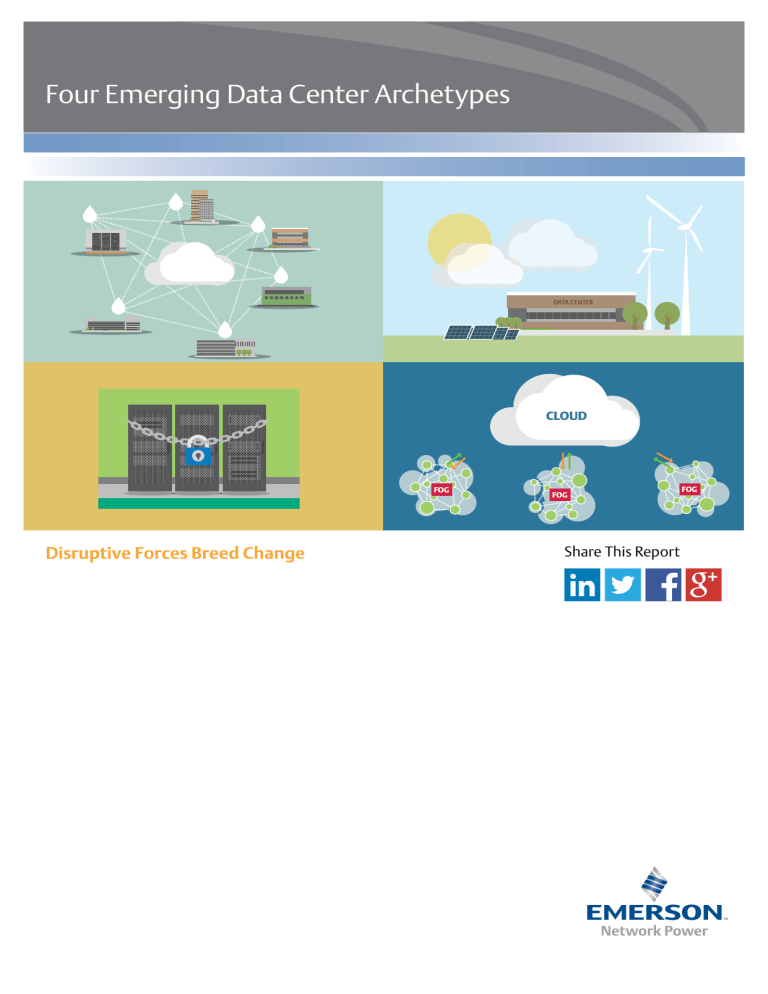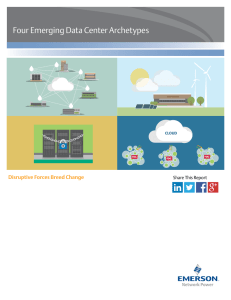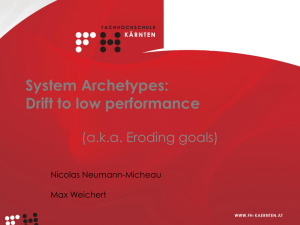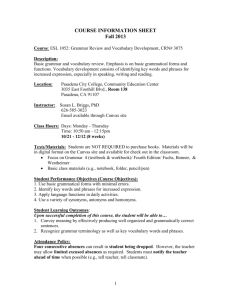Four Emerging Data Center Archetypes Disruptive Forces Breed Change Share This Report CLOUD

Four Emerging Data Center Archetypes
Disruptive Forces Breed Change
FOG
CLOUD
FOG
Share This Report
FOG
2
Data Center Archetypes
From transportation to healthcare to retail, disruptive forces are bringing challenges and opportunities to virtually every industry. The data center, an enabler of disruption in many instances, is no exception. This disruption is coming from external forces and internal pressures that are challenging existing operating paradigms and have the potential to create new data center archetypes.
The dominant enterprise archetype today is the high-availability data center, with 2N power and redundant generators and cooling. Most enterprises have added some form of Software-as-a-Service (SaaS) to their IT architecture, and a growing number are moving to or investigating a bimodal architecture that recognizes that different applications, data types and groups of users have different requirements in terms of speed of deployment, productivity, efficiency, resiliency and security. In addition, open computing and the software-defined data center have the potential to change the way IT systems are configured and supported.
The move to bimodal is not the only example of an emerging archetype. Here are four additional data center archetypes our customers are investigating.
Cloud of Many Drops
The reality of cloud computing today is that many enterprises are buying computing, primarily through
SaaS deployments, to bring applications online faster and cheaper, at a time when in-house computing resources are underutilized. Virtualization was supposed to address low server utilization rates, and has had some affect; however, a 2015 study by
Stanford’s Jonathan Koomey and Anthesis Group’s Jon
Taylor , found that enterprise data center servers still only deliver, on average, between 5 and 15 percent of their maximum computing output over the course of a year.
In addition, the study found that 30 percent of physical servers are “comatose,” meaning they have not delivered computing services in six months or more.
in increased enterprise server utilization, extended life for existing data centers that move toward a self-support model, and the ability for enterprises to build new data centers based on average rather than peak demand.
At a time when the “shared-service” model is being applied to everything from personal taxi service to legal counsel, it shouldn’t be long before a technology platform is available that enables enterprises to not only tap into this unused capacity on-demand, but also sell their excess capacity on the open market. This shared services approach could result
Data Center Archetypes
The Corporate Social Responsibility Compliant Data Center
The industry has been dealing with the challenge of efficiency since at least 2007, but the focus has largely been financial. Now, with industry energy consumption continuing to rise and gaining increased attention, some organizations are looking at how data centers fit into their corporate sustainability plans. This focus on sustainability is elevating the profile of issues such as carbon footprint, alternative energy use and responsible disposal. To be meaningful, this approach must include the full data center ecosystem, including colocations and cloud service providers.
These organizations will take a more aggressive approach to data center efficiency—adopting, for example, cooling with maximum economization and UPS systems that apply active inverter eco mode that move seamlessly to highefficiency mode—while also pushing for increased use of alternative energy, such as wind and solar, to power data center operations and achieve carbon neutrality. In light of this trend, the prediction made by Data Center 2025 participants that solar energy would account for 21 percent of data center power by 2025, which seemed extremely aggressive to some experts, may prove accurate.
The Data Fortress
The cost and frequency of data breaches continues to rise, despite the billions spent annually on digital security. The
Ponemon Institute Cost of Data Breach study shows a
23 percent increase in the cost of a privacy-related data security breach in the last two years, with total cost now at
$3.8 million. In addition, a Ponemon study of data center downtime commissioned by Emerson Network Power found that the number of security-related downtime incidents rose from 2 percent in 2010 to 22 percent in 2015. The cost and frequency are rising to the point where some organizations have no choice but to take a security-first approach to data center design.
This is already happening to some degree as organizations in medical, Industrial, pharmaceutical, financial and aerospace industries are deploying data pods within or adjacent to existing data centers specifically for sensitive data. The next wave is the purpose-built, cold-storage facility with massive storage arrays protected by heavy investments in security systems and protected from access by all but authorized networks. Colocation facilities are now offering “secure suites” with dedicated power and thermal equipment, instead of the open-caged environments that have been standard, to improve physical security in their facilities.
3
Data Center Archetypes
Fog Computing
Fog computing is a distributed computing architecture being promoted by Cisco in response to the Internet of
Things. Similar in philosophy to the micro data centers now being deployed at the network edge to provide faster access to content and applications, fog computing connects multiple small networks of industrial systems into one large network across an enterprise. In the fog, application services are distributed across smart devices and micro data centers to improve efficiency and concentrate data processing so that only actionable data is transmitted. This provides a more efficient and effective method of dealing with the immense amount of data being generated by the sensors that comprise the Internet of Things. It also allows data to be aggregated and filtered locally to preserve bandwidth for actionable data.
FOG
CLOUD
FOG
FOG
Speed, cost, security, sustainability, application availability and productivity must all be factored into future data center archetypes as data center operators deal with disruption from inside and outside their organization.
Some segments of the market are being driven primarily by one disruptive force, such as security or sustainability, to create these emerging archetypes. Most data center operators, however, will have to juggle the conflicting needs of multiple application owners or attempt to satisfy application owners who demand “all of the above.”
Software-defined management will increasingly provide the flexibility organizations need to move away from single-instance data centers in which all data and applications are treated with the same level of resiliency and security while adopting new technologies and practices being pioneered in the archetypal data centers. This will enable organizations to evolve to the data center ecosystem of the future capable of accommodating all of these disruptive trends through a multi-modal model in which the environment is tailored to specific needs of the data, applications and users it supports. By working with application owners to meet their specific needs, data center operators will have the opportunity to build on their role as service providers to become trusted advisors.
EmersonNetworkPower.eu
Emerson, Emerson Network Power, and the Emerson Network Power logo are trademarks or service marks of Emerson Electric Co.
All other names, product brands, and logos are the property of their respective owners. ©2015 Emerson Electric Co.








